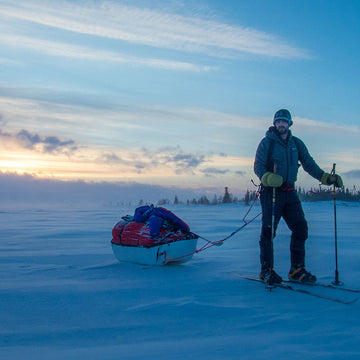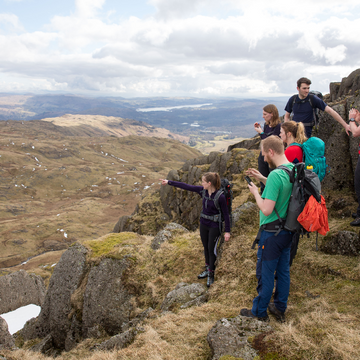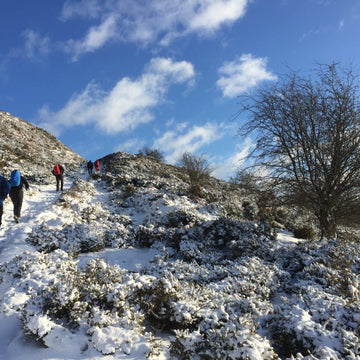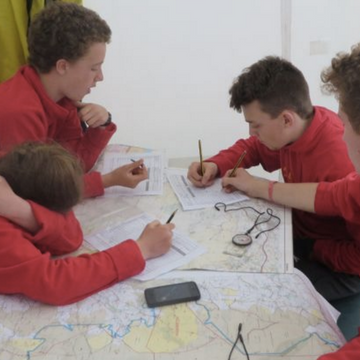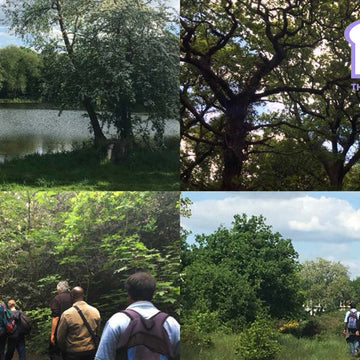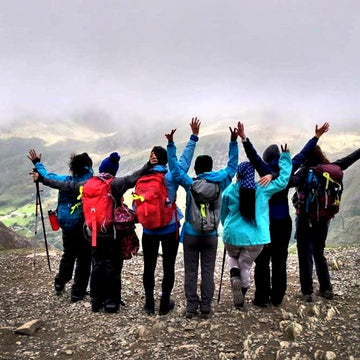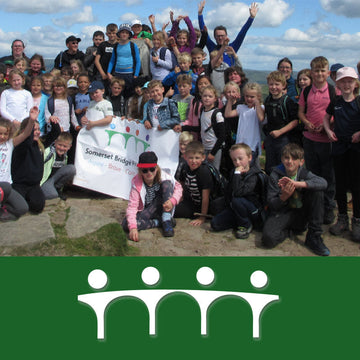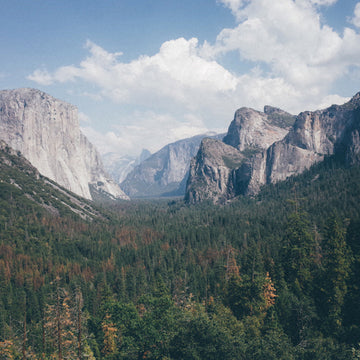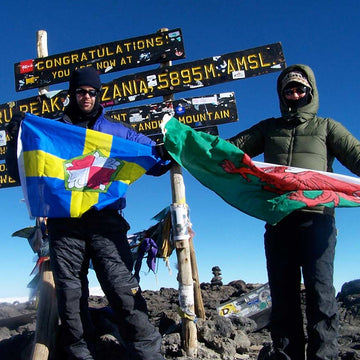
Tales from the big trails, recounting epic journeys on long-distance paths.
You're reading an extract from 'Tales of the Big Trails' by Martyn Howe. Available to pre-order here.
"I have a week to spare and check through the National Trail possibilities. The Cotswold Way fits perfectly at 102 miles in length and is close to home. By way of a train to Stratford-upon-Avon and a bus to Chipping Campden, I am standing beside a stone pillar which marks ‘COTSWOLD WAY – THE BEGINNING AND THE END’. My pedantic mind wonders how it can be both at the same time. Is this a Schrödinger’s cat thought experiment, the answer unknown until the presence of an observer? A new marker stone was installed in 2016; its inscription offers one explanation:
In my beginning is my end. Now the light falls
Across the open field, leaving the deep lane
Shuttered with branches, dark in the afternoon,
Where you lean against a bank while a van passes,
And the deep lane insists on the direction
Into the village, in the electric heat
Hypnotised. In a warm haze the sultry light
Is absorbed, not reflected, by grey stone.
The dahlias sleep in the empty silence.
Wait for the early owl.
– T.S. Eliot, from Four Quartets (1943)

Chipping Campden is a dusky Cotswold wool-market town, with an elegant terraced high street. The buildings are constructed with a warm Jurassic limestone – a distinctive motif that is pleasing to the eye. The golden hue of the stone walls and farm buildings complements the broad green fields and azure skies perfectly – a colour match an artist would use. I climb up to the ridge to views across Evesham Vale, before turning south towards Broadway Tower, at 313 metres’ elevation.
On a clear day, you can see sixteen counties from this superb viewpoint, conceived by Capability Brown and built by James Watt, in 1794. It is an imposing self-indulgent structure featuring battlements, gargoyles and turrets that serve no practical purpose; they are purely aesthetic.
I’d prefer to maintain height, but the path descends steeply into Broadway, a popular tourist destination in this area of outstanding natural beauty. It is not as busy as it can get; but the shops and cafes are full, making it difficult to find lunch unless you explore the back streets where the locals go. A simple sandwich and I’m on my way, ascending on to the ridge with views now attending the Severn Valley. The village of Stanton lies ahead; in comparison to Broadway, it is unspoilt. The golden-stone cottages jealously guard their original patina, without a hint of restoration or modernisation. Old oak doors nestle underneath the lintels, protecting hidden rooms of incredible beauty and comfort.
I meet Alex a few miles out of the village, and we walk together for a while. She is an artist who has walked a few National Trails and enjoys wild camping. We spend a couple of hours exchanging life stories, which make the miles go by. She too walked the Pennine Way a few years earlier, and we laugh at the shared experience and trials we faced.
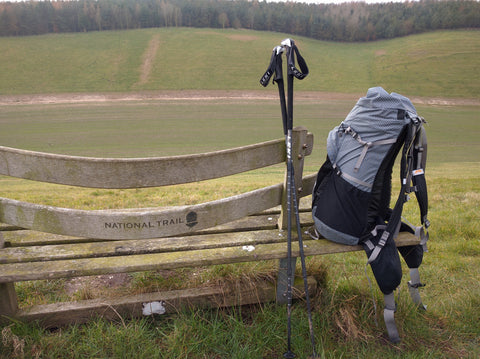
We walk past Stanway House, a stunning yellow-stone Jacobean manor house and home to the tallest fountain in Britain at ninety metres. It also holds the record for the tallest gravity-fed fountain in the world, supplied by a reservoir in the hills 180 metres above.
Only the turbine-powered fountain on Lake Geneva is higher. Such amusing facts add to the conversation, but we say our goodbyes before Winchcombe. She is off to find a campsite, which makes me feel guilty about the room I have booked at the White Hart Inn.
Ascending the next day, I reach Belas Knap Long Barrow, an early Neolithic burial chamber, some 5,500 years old. I descend again through woodland and see three shy roe deer, observing me intently before leaping away through the trees. It is a stormy, sometimes sunny, rainbow-like day, casting a regal light on Postlip Hall, a co-housing community living in a manor house nestled in a gully in the hillside. They have found a secret for sustained social harmony and living for over fifty years.
The path now follows the ridge around Cheltenham, a Regency spa town cuddled by the Cotswold Hills. Every detail can be seen: the racecourse, numerous churches, colleges and schools. A Gloucestershire Warwickshire Steam Railway train puffs away, marking its passage with plumes of steam rising in the cold morning air. The views give the impression of walking above a model village. I spend a while at Cleeve Hill studying the detail and identifying features against my OS map, confirming my sightings with a compass (usually buried deep in my rucksack). Further on, you can see the mountains of South Wales and the River Severn, which meanders out to the Bristol Channel towards the horizon.
Outside of the town lies the Government Communications Headquarters (GCHQ) – an enormous doughnut-shaped spaceship nestled in the suburbs. This organisation superseded the Government Code and Cypher School (GC&CS) in 1944. During the war, the industrialisation of intelligence gathering gave birth to the earliest computers, imagined by Alan Turing, and built by Tommy Flowers in 1941. Both the early electromechanical (Bombe) and later electronic valve-driven (Colossus) computers can still be seen at the museum at Bletchley Park. Based on the same principles, modern systems with exponentially more power analyse data in real time. New-generation artificial intelligence and quantum computers are perhaps in use today too (it’s top secret, so we don’t know). How ironic that a humble smartphone can track GCHQ employees on their lunchtime Strava runs.
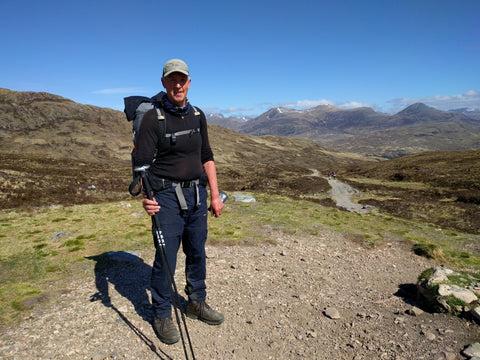
I have plenty of warning of rain showers as they arrive, donning my waterproof just seconds before the heavens open. The light is intense and fresh, illuminating the bright yellow fields of oilseed rape. The electricity pylons accurately follow the path, making navigation easy and keeping my map dry. The road noise directs me to Birdlip. The hotel is dreary, like a budget business bed block, devoid of character. At least it has a deep bath to soak my weary legs, but I wish I had brought my bivouac gear.
The evening meal and breakfast are mediocre. There seems to be an inverse correlation between price and quality in this area. Unless you wild camp (problematic in tightly managed dogwalking countryside) you have few options. Finding a campsite is difficult. Prices can escalate dramatically during the Cheltenham Festival or Badminton Horse Trials, so timing is all-important. It is perhaps the one National Trail where it is wise to book ahead.
The day starts bright as I walk along a woodland path. The bluebells and wild garlic have exploded under the beech trees. The pungent aroma is overpowering. Deer are a common sight if you tread lightly and keep your eyes open. Stop, stare and study them, until they turn into the woods. Our eyes rely on movement to detect a threat, and if you stay still, they are unsure of your intentions. The dappled light under the tree canopy enhances their camouflage. I’m sure I’d see more if I wasn’t wearing a red waterproof.
I stay with the contours to Cooper’s Hill: the site of the famous annual cheese-rolling competition held on the spring bank holiday. The event was traditionally for the village folk of Brockworth. It may derive from the pagan habit of rolling large objects down steep hills. In this case, a four-kilogram Double Gloucester cheese is released from the top of a very steep concave incline, chased by a line of competitors, who launch themselves recklessly after it.
The objective is to catch the cheese – a somewhat unachievable feat unless you exceed seventy miles per hour. The event has been summarised as ‘Twenty young men chasing a piece of cheese off a cliff, tumbling 200 yards to the paramedics who scrape them up and pack them off to the hospital!’ Health and Safety have recently intervened, and a foam cheese is now used after someone realised it could veer off course and seriously injure someone. What would England be without this mad eccentricity? The frantic nature of the competition is in contrast to meditative walking: a cadence of breath, motion and heartbeat blend with the birdsong and rustling leaves. My mental rhythms harmonise with woodland sounds; it is a joyous state to be in. I am walking without effort and without thought, almost floating. The experience can be sustained for hours if the conditions allow, but it is rare for this to happen.
Dodging golf balls at Painswick golf course, I enter the historic wool town in search of lunch. The churchyard is resplendent with ninety-nine yew trees, neatly trimmed, standing like lost souls in the graveyard. A strict building code protects the soft-yellow stone buildings. You are viewing a scene unchanged in 200 years; the only foreign objects are motor vehicles and people wearing unnatural colours. Bluebells and wild garlic are replaced by fields of buttercups as I pass a sign indicating fifty-five miles to Bath.
Almost halfway now. I stop at a topograph, which shows the relief of the landscape and my position in it. The brass ridges on the dial are polished by the touch of a million human fingers, revealing the famous landmarks – the top ten views, as voted by generations of walkers. The panorama is extensive: both Severn bridges can clearly be seen to the south-west of the escarpment, deeper Wales to the west, Herefordshire to the north – the land carved by the Severn estuary that runs to the Bristol Channel.
Dropping into Stroud to cross the River Frome I walk past private school playing fields. The girls are playing rounders, the boys cricket, confirming stereotypes. All of them follow a strict dress code. It is like a fashion prison with no possibility of deviation. I only have a few miles to go before reaching a B&B in Middleyard. The landlady is very welcoming, and I can relax in her conservatory, overlooking the fields. The house is spotless. It is time to book one more night’s accommodation and catch up with some reading. The chair envelops me in comfortable cushions almost to the point where I cannot stand. A cuddly toy drops on my lap, one of a selection that rests on the furniture.

My walking meditation continues the next morning through superb woodlands that blanket the steeper sections of the landscape, the trees unspoilt and intact purely because the land cannot be cultivated. Long barrows and ancient hillforts command strategic views across the River Severn into Wales. Iron Age communities established defensive strongholds on isolated geological anomalies, somehow detached from the main escarpment, floating out to sea. I hitch a ride on Cam Long Down into Dursley – a popular centre for walkers.
My relaxed pacing ends. I must climb steeply out of the town on to a downland tabletop peninsula that hosts a golf course. A circumnavigation is rewarded with exceptional views. Who could argue that ‘golf is a good walk spoiled’ with such an outlook? It is a pity to lose height again into a valley peppered with freshwater springs, to climb once more to the Tyndale monument on Nibley Knoll. This structure commemorates the life of William Tyndale, the scholar who first translated the Bible into English. I stand two metres in front of a building that has piqued my curiosity for two days; it occupies such a prominent position on the ridgeline.
En route to Wotton-under-Edge, I take lunch beneath a cluster of pine trees. Planted initially to mark the Battle of Waterloo in 1815, they were chopped down and burnt at the end of the Crimean War in 1856 and replanted again for Victoria’s Golden Jubilee in 1887. Death and rebirth. I add a small pine cone to my backpack, one of a thousand that litter the ground – a good luck charm with excellent ancestry.
The town is busy with shoppers and traffic, but I have no reason to stop. I meet a trio of walkers in training for the Yorkshire Three Peaks; I have to up my pace to stay with them. They circle back, and I then meet another group, who are uncomfortable crossing a field with cattle blocking the path. The cows are with calves, so we give them a wide berth. A dog off its lead doesn’t help, and the cows are intelligent enough to know the owners command them. Several years spent working on farms has taught me enough to understand their basic behaviour, but they still frighten me at times. Safely across, I head for Hawkesbury Upton and the Fox Inn. It is a comfortable stay with an excellent embedded Italian restaurant, managed by welcoming hosts. A glass of red is more than enough to initiate deep sleep to finish my day. I forget to write up my journal.
Now I have a twenty-five-mile sprint into Bath to catch a train home. I’m in the mood for a fast-paced march, without regard to the views; it is rare for me to be an athlete and not a rambler. I scoff the bacon roll that has been left for me, with instructions on how to let myself out. I’m on a mission – starting now at 6 a.m. The heavy dew soaks my boots thoroughly, but I don’t mind. I love being up this early before the villages wake. The route is mostly arable farmland now, with few woodland areas. This is not a day for meditation. I am striding out, breathing in the dense dawn air with eyes forward and arms swinging.
Dropping down into Horton Court there is a grand pepperpot folly, designed to provide a home for swallows and owls. Asteriskshaped windows discourage pigeons from squatting. I progress through sleepy villages and fields, past yet more Iron Age forts towards the unmistakable white-noise drone of the M4. I reach the motorway via Dodington Park, another landscape designed by Capability Brown. It is full of ancient oaks and clumps of woodland laid out like a well-composed painting.
I cross the motorway and walk under enormous pylons, launching their high-tension cables off the hill to span the estuary towards South Wales. A strip-lynchet field system leads past Dryham Park, an impressive baroque country house and deer park. I stop briefly at a petrol station on the A46 for Snickers bar fuel, which I need to negotiate the rugged hills ahead towards Lansdown Hill. On this tabletop-shaped down, contour lines stop at 230 metres, as if a potter has shaved off the wet clay peak with wire before firing the Cotswold Hills in the oven. The flat grasslands are ideal for a racecourse or a conflict. The Battle of Lansdowne, in 1643, is marked by a simple stone which depicts a looting soldier, to add to the many monuments in England that commemorate bloody conflict between Royalists and Parliamentarians. Today, Bath racecourse hosts regular flat races – horses at leisure rather than at war.


![Definition [Mens]](http://eu.alpkit.com/cdn/shop/files/Definition-men-2.jpg?v=1764357328&width=768)

![Definition [Womens]](http://eu.alpkit.com/cdn/shop/files/Definition-women-3.jpg?v=1764357395&width=768)
![Balance [Mens]](http://eu.alpkit.com/cdn/shop/files/balance-mens-2025-reef.jpg?v=1765566341&width=768)
![Balance [Mens]](http://eu.alpkit.com/cdn/shop/files/Balance-mens-2.jpg?v=1765566341&width=768)
![Balance [Womens]](http://eu.alpkit.com/cdn/shop/files/balance-womens-2025-black.jpg?v=1765566432&width=768)
![Balance [Womens]](http://eu.alpkit.com/cdn/shop/files/Balance-womens-3.jpg?v=1765566432&width=768)
![Fortitude [Mens]](http://eu.alpkit.com/cdn/shop/files/fortitude-mens-2025-alder.jpg?v=1765566372&width=768)

![Fortitude [Womens]](http://eu.alpkit.com/cdn/shop/files/fortitude-womens-2025-alder.jpg?v=1764270237&width=768)




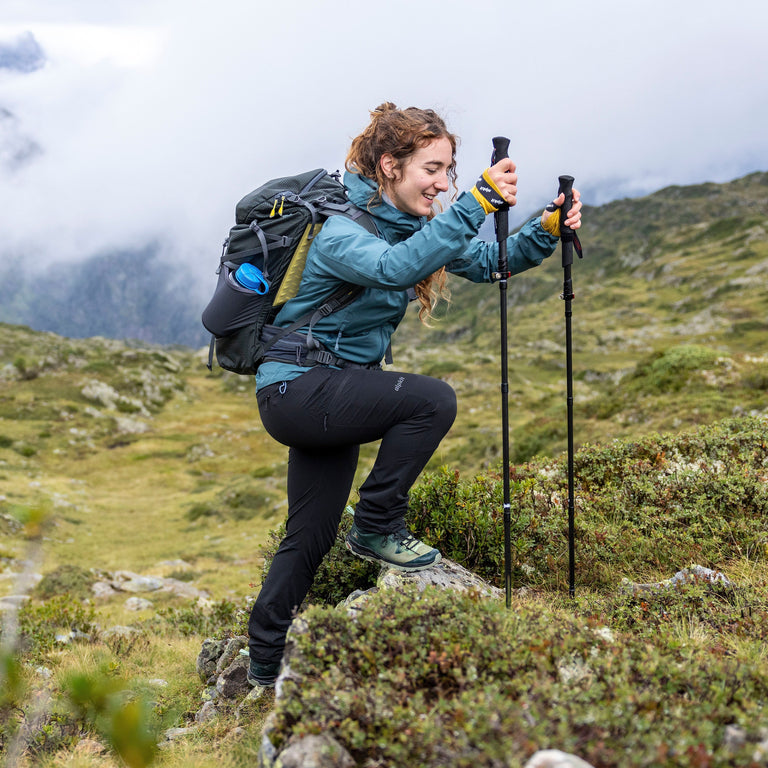




![Gravitas [Mens]](http://eu.alpkit.com/cdn/shop/files/mens-gravitas-2025-chilli.jpg?v=1765566317&width=768)
![Gravitas [Mens]](http://eu.alpkit.com/cdn/shop/files/gravitas-location-1-RETOUCH.jpg?v=1765566317&width=768)
![Gravitas [Womens]](http://eu.alpkit.com/cdn/shop/files/womens-gravitas-reef.jpg?v=1764270267&width=768)


